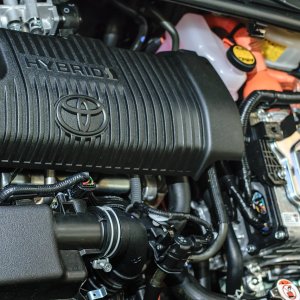
Natural Gas, Hydrogen to Power the Vehicles of Tomorrow
 By Antonio Gozain | Senior Journalist and Industry Analyst -
Wed, 08/24/2022 - 08:00
By Antonio Gozain | Senior Journalist and Industry Analyst -
Wed, 08/24/2022 - 08:00
As the world advances toward decarbonization, the automotive industry remains at the center of the conversation. While battery electric vehicles’ (BEVs) popularity grows, stakeholders continue betting on alternative, sustainable fuels to power internal combustion engine (ICE) vehicles as an extra effort to reduce carbon emissions.
Although the costs of using sustainable fuels are projected to be higher than long-term alternatives, such as BEVs, the use of these fuels can achieve comparable greenhouse-gas (GHG) reduction, enabling faster decarbonization of existing fleets in the short term, according to McKinsey. In addition, commercial heavy transportation is expected to see electrification only in the longer term. Therefore, sustainable fuels for trucks and buses are set to play a pivotal role in the industry’s path toward decarbonization.
BEVs are not the only alternative for sustainable passenger cars, either. Fuel cell electric vehicles (FCEVs), powered by hydrogen, have been available in the market for several years. These vehicles use stored hydrogen to produce electricity. Similar to ICE engine vehicles, they can fuel in less than 5 minutes and have a driving range over 480 kilometers. Currently, Hyundai, Toyota and Honda offer FCEVs in the US and Japanese markets, including both SUVs and sedans. These vehicles are more efficient than ICE units and produce no tailpipe emissions. FCEVs only emit water vapor and warm air as residue. Their adoption, however, has been hampered by the necessary infrastructure to fuel, which is still in its early stages of implementation, according to the US Department of Energy.
“BEVs and FCEVs will be Hyundai Motor Group’s ultimate technologies to achieve carbon neutral mobility, while eco-friendly ICE technology that combines eco-friendly fuel and ultra-lean burn engine will be the key to effectively reduce GHG emissions during our transition to EVs,” said Alain Raps, Executive Vice President, Hyundai Motor Group and Leader, Electrified Propulsion Technical Unit.
Natural Gas: Challenges
One of the proposed alternatives to traditional ICE fuels is natural gas, which offers several benefits to users, from safety to savings. Natural gas is less flammable and safer than gasoline. Lighter than air, it dissipates quickly in case of accidents. However, this fuel remains far from being adopted by the public, globally. Currently, there are over 40 million natural gas vehicles (NGV) worldwide, according to Mexico’s Vehicle Natural Gas Association (AMGNV).
In 2019, there were around 15,000 NGVs operating in Mexico, of which 45 percent were taxis, 40 percent cargo trucks and 15 percent buses, according to Deloitte. By the end of 2021, the country’s NGV fleet grew to over 62,000 vehicles, according to AMGNV.
Natural gas production in Mexico is mostly destined to PEMEX, however. But, the country has one major advantage: it is close to the US and therefore close to some of the cheapest natural gas available in the world, as reported by MBN. With Mexico’s pipeline growing on a yearly basis, wider access to compressed and liquified natural gas (CNG) and (LNG) could become more feasible, as well.
Using natural gas for heavy duty vehicles has become increasingly attractive in recent years. Costs for LNG and CNG are relatively low. There are also clear environmental benefits and the fuels also run very silent when burned. NGVs generate 26 percent less carbon dioxide emissions than traditional ICE engine vehicles. “Natural gas reduces CO2 emissions by 70 percent in comparison to diesel and is 50 percent cheaper per kilometer than traditional fuels,” said Luis Echavarría, Director General, Enco GNV, in an interview with MBN.
While the benefits of growing Mexico’s NGVs fleet are clear and the figures show an important increase over the past few years, these are still far from representing a significant percentage of the country’s heavy vehicle fleet. One of the main issues holding back NGVs has been the limited number of refueling stations across Mexico. In addition, NGVs are usually expensive, making the upfront cost high for some users.
Mexican natural gas refueling stations grew exponentially during the pandemic, nevertheless. There are 85 stations currently operating, with other 67 under development and construction, according to AMGNV. However, there are close to 13,000 gasoline stations in Mexico, according to Statista.
The scarcity of natural gas refueling stations in Mexico could be associated with incentives. Consumers are not motivated to buy NGVs due to the very small number of stations available, while companies do not invest millions of dollars in building these stations, since nobody owns NGVs. "The most important challenge is to duplicate the NGV fleet and the construction of new refueling stations, CNG loading terminals and cryogenic plants for the liquefaction of LNG," said Andrés Bayona, President, AMGNV.
FCEVs: Challenges
Research and commercial efforts continue to expand the limited hydrogen fueling infrastructure and increase the production of FCEVs. When used in a fuel cell to provide electricity, hydrogen is a zero tailpipe emissions alternative fuel, according to the US Department of Energy. Drivers of FCEVs can fuel up at retail stations in less than 5 minutes, similar to ICE engine vehicles and obtain a driving range of about 480km.
With 142 new hydrogen refueling stations, the total amount of stations by 2021 was just 685 worldwide. Just like with natural gas, there is a problem of incentives to open more stations but also to buy FCEVs. However, in this particular case, the situation also includes skepticism from some players regarding the potential of hydrogen for vehicle applications.
According to The Conversation, hydrogen is inefficient. In FCEVs, energy must move from wire to gas to wire in order to power the car. Compared with BEVs, FCEVs are considerably less efficient, the article says. “Let’s take 100W of electricity. To power an FCEV, that energy has to be converted into hydrogen, possibly by passing it through water (the electrolysis process). This is around 75 percent efficient, which means that a quarter of the electricity is automatically lost.” Then, the hydrogen produced has to be compressed, chilled and transported to the refueling station, “a process that is around 90 percent efficient.” Once inside the car, hydrogen must be converted to electricity, a 60-percent efficient process, to finally power the motor to move the vehicle at a 95 percent efficiency rate. “Put together, only 38 percent of the original electricity – 38W out of 100 – are used.”
The hydrogen fuel cell requires double the amount of energy than BEVs, says BMW: “The overall efficiency in the power-to-vehicle-drive energy chain is therefore only half the level of a BEV.” Volkswagen made a similar statement comparing the energy efficiency of both technologies. “The conclusion is clear. In the case of the passenger cars, everything speaks in favor of batteries and practically nothing speaks in favor of hydrogen.”
However, the US Office of Energy Efficiency and Renewable Energy (EERE) still believes in FCEVs’ potential. Although it remains pricey and limited to certain regions, hydrogen is not an expensive fuel and 10 million tons of it are produced annually. While FCEVs remain the most expensive vehicle to refuel, they can drive up to twice as far as ICE vehicles. In addition, the popularization of this technology would drive prices down, says EERE.
Today’s commercial FCEV market is limited to three models sold in California, where most hydrogen-refueling stations are located and where the government offers incentives to customers for their purchase. The Honda Clarity, for instance, comes with a US$15,000 fuel credit from the OEM, just like the Toyota Mirai. The Hyundai Nexo, an SUV, comes with free hydrogen fuel for three years.
















